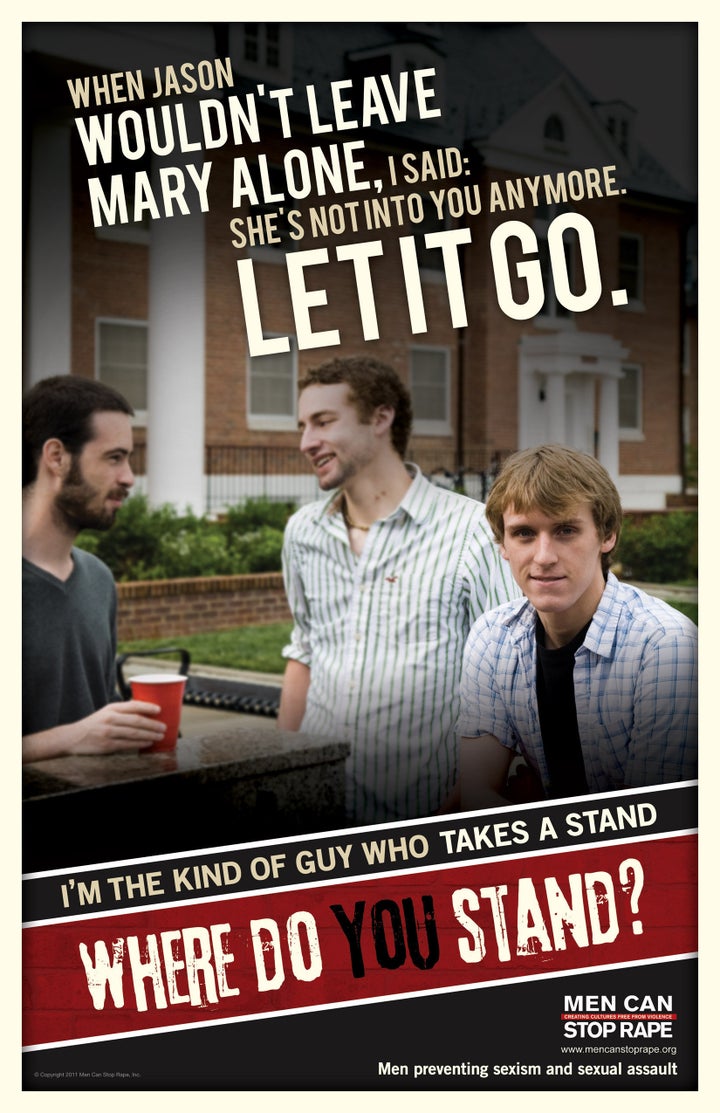Today the FBI updated it's circa 1920 definition of rape. Until today, rape was still defined as "The carnal knowledge of a female forcibly and against her will." It was changed to one that makes no reference to gender and that will include male, mentally impaired and non-consensual victims. Even though this change is already reflected in the laws of many states, there will undoubtedly be in increase in the number of rapes recorded in the nation.
As it is, according to December's CDC study and the Department of Justice, 20 percent of all women, 1 in 5 report experiencing rape or an attempted rape. That number is 1 in 71 for men. The Department of Justice estimates that 60 percent of rapes go unreported. Rape is in our air.
On any given day you can, if you chose, participate in an entertaining pop culture rape happening. Last week started with Salon's Glenn Greenwalk making jokes about President Obama raping nuns and in December, #ItAintRapeIf, a fun Twitter hash tag was trending. You can find popular TV shows and movies and lists of music with rapey lyrics to hyper-real, 3-D video games like RapeLay (which went viral last year), in which players help the hero rape a mother and her two daughters. Facebook still has its controversial rape pages. Rape talk, as in "that was just like being raped," long indulged in by right-wing shock jocks is now regular slang. Not quite convinced? How about the "Who Would You Rape?" University of Vermont fraternity survey? And, of course, someone will fill a book with the shame of Penn State.
These examples are rape culture manifest: sexual violence -- overwhelmingly against girls and women -- tolerated, excused, ignored and normalized through attitudes, norms, practices and media. Childhood victims of abuse, boys included, are victims of rape culture, too.
As significant as the FBI decision is, it will not dismantle this culture. Instead, with an increase in the number of rapes and a broadening of the possible victims and perpetrators, there will probably be a net increase in rape myth conversations and media coverage. We ignore, debate, glamorize and debunk real rape instead of challenging the culture that makes it endemic. Consider the impact of NOT doing the following:
- Exaggerating the incidence of false rape claims. A 2002 survey of male and female college students, surveyed revealed that they believed a woman lies in 50 percent of reported rape cases. The FBI estimates that 1-2 percent of claims are actually fake. A 2009 Slate article, examining competing quantifying claims about false accusations, concluded that the best maximum estimate for false claims, based on a survey of multiple large-scale investigations around the world, was between 8 percent and 10 percent. Yet, it's a common refrain and mainstream media delights in sensationalizing false accusation stories. We eat them up with seeming relief. There are far more women being raped (and even more not reporting being raped) than there are lying about it.
Portraying rape, in speech and media and news, primarily as forcible and heterosexual. Changing the FBI definition won't change this anytime soon. Boys in particular pay the price for this myth. December's CDC study revealed that boys are twice as likely to be raped as children - 28 percent of male rape victims reported being raped between the ages of 6-10, after which the incidence of assaults drops off, versus 12 percent of girls, for whom the incidence peaks in their teens through twenties (but virtually never ends.) According to Advocates for Youth: "Male victimization is particularly hard to estimate due to beliefs that only girls can be abused; that sex between older women and boys is desirable; that male victimization of boys indicates lack of masculinity and/or acquiescence by the child." Sexism, misogyny, gender stereotypes and, yes, rape culture are to blame for that. Talking about women raping men as though there is an equivalence. and not a larger culture of violence against women that rape is a part of. Saying that sexual and domestic violence is used to control girls and women disproportionately does not mean that boys' and men's experiences of assault and rape are in any way less relevant or horrific. In statistical terms, however, right now, while data on female sexual assault is hard to gather and verify, it's exactly like pointing out that some men get breast cancer every time the subject of women's breast cancer fatalities comes up. Raising the spectre of women raping and implying equivalence is an absurd misrepresentation. According to December's CDC report, in the US, between 1 percent and 2 percent of men have been raped or experienced an attempted rape, compared to 20 percent of women. That 1-2 percenet is a total -- not just those where there may be female perpetrators. Teaching girls, and not boys, rape prevention tips. Rape prevention is important and every girl and woman, whether she realizes it or not, has her own battery of techniques to avoid assault. However, imagine, as Canyourelate.org recently did to dramatically illustrate just this point, if rape prevention tips were instead, among others: "Don't put drugs in women's drinks" or "When you see a woman asleep, don't rape her." But, what if boys were taught to intervene? To not make jokes and call each other homophobic names? No amount of lists, advice and checklists will stop rape until boys and men learn to empathize, step in to inhibit aggressive friends and help their female friends and relatives when there is ambiguity or potential harm. Blaming and slut-shaming victims. "She asked for it." "She was drunk." "Did you see what she was wearing?" The most extreme illustration is last year's repeated gang raping of an 11-year old girl in Texas. The New York Times highly criticized reporting about the rape(s) quoted members of the community as saying of the girl, "She dressed older than her age, wearing makeup and fashions more appropriate to a woman in her 20s." For some reason this was a consideration when between 5-18 boys and men, some of whom circulated phone videos, repeatedly kidnapped and raped her. Obviously girls and women have a responsibility to be careful and safe, but boys and men have to know that the way a woman dresses or her use of alchohol does not entitle them to rape her. Girls will dress in ways that invite the "wrong attention." They will be sexually aggressive. They will drink. Just like boys. We have to be clear about saying that consent (and the ability to give consent) are necessary before sex. This is why the SlutWalk movement is so important. Not loudly and clearly condemning unrepentant abusers and rapists. In fact, we continue to protect, reward and glorify perpetrators of violence against women financially when they are celebrities, athletes, entertainers and public figures. This adulation of popular and entertaining abusers supports environments of structural violence. How many people spend money and time seeing Mel Gibson, listening to Chris Brown, watching Roman Polanski films, protesting Joe Paterno's firing. When it happens do you say to your kids "Where was that girl's mother?" or "She put herself in that situation," instead of saying "I will not pay to download his music because he's an unrepentant abuser," or "I'm sure that movie is good, but he drugged and raped a 13 year old girl and then fled the country." Teaching moments are just as effective when you don't say anything. Saying "I don't rape and I don't know any rapists." I don't think men should feel gender guilt for the predatory behavior of repeat rapists. But, I also think that moving conversations about rape to defensive, personal and anecdotal levels is destructive, misleading and counterproductive. As Hugo Schwyzer, professor of History and Gender at Pasadena College recently pointed out (to some controversy) in a recent article, men should be angry, not at feminists and people who point out rape facts, but at a rape culture's portraying them as animals, unable to control their violent, aggressive sexuality. And, even though I don't think men are guilty by gender, I do think that what is usually cast as a "women's issue" is a "men's problem." Given the statistics about rape, and barring any transformative planetary event, only
Men Can Stop Rape.
That is actually is the name of a movement whose potential influence can't be overestimated. Their approach, which largely focuses on college age men, is ingrained with empathy and employs critical thinking and awareness to motivate boys and men to use their strength for good. Their
is to mobilize men to create cultures free from violence, especially men's violence against women. They teach boys and men how to positively change their understanding of masculinity, sex and relationships to end gender-based violence. I only wish they could start their programs, in age appropriate ways, in pre-school. Cross-gender empathy, a significant component of men understanding how the threat and reality of rape affects women's lives, is
.
Many rapists operate unchallenged. And they do because we make them comfortable doing it by misrepresenting, ignoring, debating and trivializing rape. There are those of us who believe that there can be a world where rape is not a daily fact of life. I'm one of them.
Support HuffPost
Our 2024 Coverage Needs You
Your Loyalty Means The World To Us
At HuffPost, we believe that everyone needs high-quality journalism, but we understand that not everyone can afford to pay for expensive news subscriptions. That is why we are committed to providing deeply reported, carefully fact-checked news that is freely accessible to everyone.
Whether you come to HuffPost for updates on the 2024 presidential race, hard-hitting investigations into critical issues facing our country today, or trending stories that make you laugh, we appreciate you. The truth is, news costs money to produce, and we are proud that we have never put our stories behind an expensive paywall.
Would you join us to help keep our stories free for all? Your contribution of as little as $2 will go a long way.
Can't afford to donate? Support HuffPost by creating a free account and log in while you read.
As Americans head to the polls in 2024, the very future of our country is at stake. At HuffPost, we believe that a free press is critical to creating well-informed voters. That's why our journalism is free for everyone, even though other newsrooms retreat behind expensive paywalls.
Our journalists will continue to cover the twists and turns during this historic presidential election. With your help, we'll bring you hard-hitting investigations, well-researched analysis and timely takes you can't find elsewhere. Reporting in this current political climate is a responsibility we do not take lightly, and we thank you for your support.
Contribute as little as $2 to keep our news free for all.
Can't afford to donate? Support HuffPost by creating a free account and log in while you read.
Dear HuffPost Reader
Thank you for your past contribution to HuffPost. We are sincerely grateful for readers like you who help us ensure that we can keep our journalism free for everyone.
The stakes are high this year, and our 2024 coverage could use continued support. Would you consider becoming a regular HuffPost contributor?
Dear HuffPost Reader
Thank you for your past contribution to HuffPost. We are sincerely grateful for readers like you who help us ensure that we can keep our journalism free for everyone.
The stakes are high this year, and our 2024 coverage could use continued support. If circumstances have changed since you last contributed, we hope you’ll consider contributing to HuffPost once more.
Already contributed? Log in to hide these messages.

